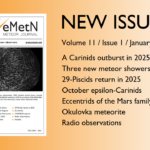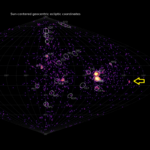By Hiroshi Ogawa and Hirofumi Sugimoto
Abstract: Worldwide Radio Meteor Observations recorded strong Quadrantid activity in 2021. The strong peak was observed at λʘ = 283.11°. This peak was twice as strong as in previous years. The other sub-peak occurred at λʘ = 282.77°. It is possible that the estimated ZHRr reached a value of over 200 during the time bin λʘ = 282.0°–283.1°.
1. Introduction
Worldwide radio meteor observation data were provided by the Radio Meteor Observation Bulletin (RMOB) (Steyaert, 1993) and by the radio meteor observation network in Japan (Ogawa et al., 2001). Radio meteor observations are possible even with bad weather and during daytime.
2. Method
For analyzing the worldwide radio meteor observation data, the meteor activity is calculated by the “Activity Level” index (Ogawa et al., 2001). The activity profile was estimated by the Lorentz activity profile (Jenniskens et al., 2000). Besides of this analysis, also the Zenithal Hourly Rates were estimated (Sugimoto, 2017).
3. Results
Figure 1 shows the result for the Quadrantids 2021 based on the calculations with the Activity Level Index. The line represents the average for the period of 2001–2020. The higher activity was very distinct compared with past returns. The maximum activity level was estimated 7.8 ± 1.1 at λʘ = 283.11° (January 3, 13h UT). The other peak was detected at λʘ = 282.77° (January 3, 5h UT) with an Activity Level = 5.8 ± 1.0. Table 1 shows the results around the peak value.

Figure 1 – The Activity Level Index by radio meteor observations from all over the world (the line is the average obtained for the period of 2001–2020).
Table 1 – The Activity Level Index around the peak time, Av01–20 means the average for the period of 2001–2020.
| Date (UT) | λʘ | ActivityLevel | Av01–20 | Date (UT) | λʘ | ActivityLevel | Av01–20 |
| Jan.2, 12h | 282.046° | 0.4±0.2 | 0.4 | Jan.3, 12h | 283.065° | 6.8±0.9 | 3.8 |
| Jan.2, 13h | 282.089° | 1.0±0.3 | 0.4 | Jan.3, 13h | 283.108° | 7.8±1.1 | 3.9 |
| Jan.2,15h | 282.173° | 0.6±0.3 | 0.5 | Jan.3, 14h | 283.150° | 7.5±1.0 | 4.0 |
| Jan.2,16h | 282.216° | 0.8±0.4 | 0.5 | Jan.3, 15h | 283.193° | 6.5±0.6 | 3.9 |
| Jan.2,17h | 282.258° | 1.1±0.4 | 0.5 | Jan.3, 16h | 283.235° | 6.7±0.7 | 3.7 |
| Jan.2,18h | 282.301° | 1.3±0.3 | 0.6 | Jan.3, 17h | 283.277° | 5.3±1.1 | 3.4 |
| Jan.2,19h | 282.343° | 1.0±0.2 | 0.6 | Jan.3, 18h | 283.320° | 4.1±0.5 | 3.0 |
| Jan.2,20h | 282.386° | 1.1±0.2 | 0.7 | Jan.3, 19h | 283.362° | 3.0±1.1 | 2.7 |
| Jan.2,21h | 282.428° | 0.1±0.2 | 0.8 | Jan.3, 20h | 283.405° | 1.5±0.4 | 2.3 |
| Jan.2,23h | 282.513° | 2.2±0.4 | 0.9 | Jan.3, 21h | 283.447° | 0.8±0.5 | 2.0 |
| Jan.3,00h | 282.556° | 1.6±0.7 | 1.0 | Jan.3, 23h | 283.532° | 1.4±0.3 | 1.5 |
| Jan.3,01h | 282.598° | 2.2±0.6 | 1.1 | Jan.4, 00h | 283.575° | 0.4±0.3 | 1.3 |
| Jan.3,02h | 282.641° | 3.8±0.6 | 1.3 | Jan.4, 01h | 283.617° | 0.6±0.4 | 1.2 |
| Jan.3,03h | 282.683° | 4.5±0.6 | 1.4 | Jan.4, 02h | 283.660° | 0.5±0.2 | 1.0 |
| Jan.3,04h | 282.725° | 3.7±0.7 | 1.6 | Jan.4, 03h | 283.702° | 0.5±0.2 | 0.9 |
| Jan.3,05h | 282.768° | 5.8±1.0 | 1.8 | Jan.4, 04h | 283.745° | 0.2±0.3 | 0.8 |
| Jan.3,06h | 282.810° | 4.7±0.5 | 2.1 | Jan.4, 05h | 283.787° | 0.6±0.2 | 0.7 |
| Jan.3,09h | 282.938° | 2.6±0.6 | 2.9 | Jan.4, 06h | 283.829° | –0.1±0.1 | 0.7 |
| Jan.3,10h | 282.980° | 4.6±0.8 | 3.2 | Jan.4, 09h | 283.957° | –0.1±0.3 | 0.5 |
| Jan.3,11h | 283.023° | 6.9±0.8 | 3.5 | Jan.4, 10h | 283.999° | 0.2±0.2 | 0.4 |
Figure 2 shows the detailed Quadrantid 2021 activity structure with the two components separated using the Lorentz activity profile (Jenniskens, 2000). One component (Comp. 1) has a peak activity level of 7.5 at λʘ = 283.11° (January 3, 13h UT) with full width half maximum (FWHM) –3.5 / +4.5 hours. The other component (Comp. 2) reached an activity level of 4.0 at λʘ = 282.77° (January 3, 5h UT) with full width half maximum (FWHM) –4.0 / +1.5 hours (see Table 2).

Figure 2 – Estimated components using the Lorentz profile. The curve with triangles represents Comp. 1, the curve with the squares is Comp. 2. The black line represents Comp. 1 and Comp. 2 combined. The circles with error margins are the Quadrantids observed in 2021.combined. The circles with error margins are the Quadrantids observed in 2021).
Table 2 – The estimated components of the Quadrantids 2021 (annual represents the average for the period of 2001–2020).
| Comp. | Maximum (UT) | λʘ | Activity Level | FWHM (hours) |
| Comp. 1 | Jan.3, 13h | 283.11° | 7.5 | –3.5 / +4.5 |
| Comp. 2 | Jan.3, 05h | 282.77° | 4.0 | –4.0 / +1.0 |
| Annual | Jan.3, 14h | 283.15° | 4.0 | –8.0 / +7.0 |
4. Discussion
4.1. Estimated ZHRr
The Zential Hourly Rate (ZHRr), on the other hand, was estimated by using the Radio Meteor Observations (Figure 3). Peak times occurred at January 3, 11h (λʘ = 283.02°), and 5h (λʘ = 282.77°). The estimated ZHRr reached 278 ± 21 and 125 ± 9. Since the peak ZHRr was too strong, it needs to be compared with visual and video observations in the future.

Figure 3 – The estimated ZHRr (the solid line represents the average for the period of 2004–2020).
4.2. Strong activities
Quadrantids sometimes showed a strong activity. During the analyzed period (2001–2021), such strong activities were recorded in 2002, 2004, 2014, 2016, 2019 and 2021 (Ogawa and Steyaert, 2017). Figure 4 shows the result of the four recent strong activities with the peak activity level. Although there were not enough data in 2002 and 2004, strong activities occurred at λʘ = 283.31° and λʘ = 283.13°. The sub-peak observed at λʘ = 282.77° in 2021 was also present in 2008 (λʘ = 282.72°), 2011 (λʘ = 282.88°), 2019 (λʘ = 282.91°) and 2020 (λʘ = 282.52°). It needs to be discussed what caused these two characteristics.

Figure 4 – Strong Quadrantid actitivities in 2014, 2016, 2019 and 2021 (the solid line represents the average for the period of 2001–2020).
Acknowledgment
The Quadrantids 2021 data were provided by the following observers:
Chris Steyaert (Belgium), Felix Verbelen (Belgium), Johan Coussens (Belgium), ALFAPCE-R0 (Czech Republic), DDMTREBIC-R3 (Czech Republic), FLZ-R0 (Czech Republic), HFN-R1 (Czech Republic), OBSJAROMER-R5 (Czech Republic), OBSUPICE-R6 (Czech Republic), ZEBRAK-R5 (Czech Republic), ZVPP-R7 (Czech Republic), Cousin Marie-Helene (France), Daniel D SAT01_DD (France), Jean Marie F5CMQ (France), WHS Essen (Germany), Per DL0SHF (Germany), Balogh Laszlo (Hungary), Istvan Tepliczky (Hungary), Fabio Moschini IN3GOO (Italy), GAML Osservatorio Astronomico Gorga (Italy), Mario Bombardini (Italy), Hirofumi Sugimoto (Japan), Hironobu Shida (Japan), Hirotaka Otsuka (Japan), Kenji Fujito (Japan), Masaki Kano (Japan), Masaki Tsuboi (Japan), Nobuo Katsura (Japan), Tomohiro Nakamura (Japan), Salvador Aguirre (Mexico), Juan Zapata (Mexico), Rainer Ehlert (Mexico), Kees Meteor (Netherlands), Rafael Martinez (Puerto Rico), Karlovsky Hlohovec Observatory (Slovakia), Jose Carballada (Spain), Jochen Richert (Switzerland), Bill Ward (UK), Ian Evans (UK), Philip Norton (UK), Simon Holbeche (UK), Mike Otte (USA), Stan Nelson (USA).
The worldwide data were provided by the Radio Meteor Observation Bulletin (RMOB) (http://www.rmob.org/).
References
Jenniskens P., Crawford C., Butow S. J., Nugent D., Koop M., Holman D., Houston J., Jobse K., Kronk G., and Beatty K. (2000). “Lorentz shaped comet dust trail cross section from new hybrid visual and video meteor counting technique imprications for future Leonid storm encounters”. Earth, Moon and Planets, 82–83, 191–208.
Ogawa H., Toyomasu S., Ohnishi K., and Maegawa K. (2001). “The Global Monitor of Meteor Streams by Radio Meteor Observation all over the world”. In, Warmbein Barbara, editor, Proceeding of the Meteoroids 2001 Conference, 6-10 August 2001, Swedish Institute of Space Physics, Kiruna, Sweden. ESA Publications Division, European Space Agency, Noordwijk, The Netherlands, pages 189–191.
Ogawa H. and Steyaert C. (2017). “Major and Daytime Meteor Showers using Global Radio Meteor Observations covering the period 2001–2016”. WGN, Journal of the International Meteor Organization,45, 98–106.
Rendtel J. (2020). 2021 Meteor Shower Calendar. International Meteor Organization.
Sugimoto H. (2017). “The New Method of Estimating ZHR using Radio Meteor Observations”. eMetN, 2, 109–110.




